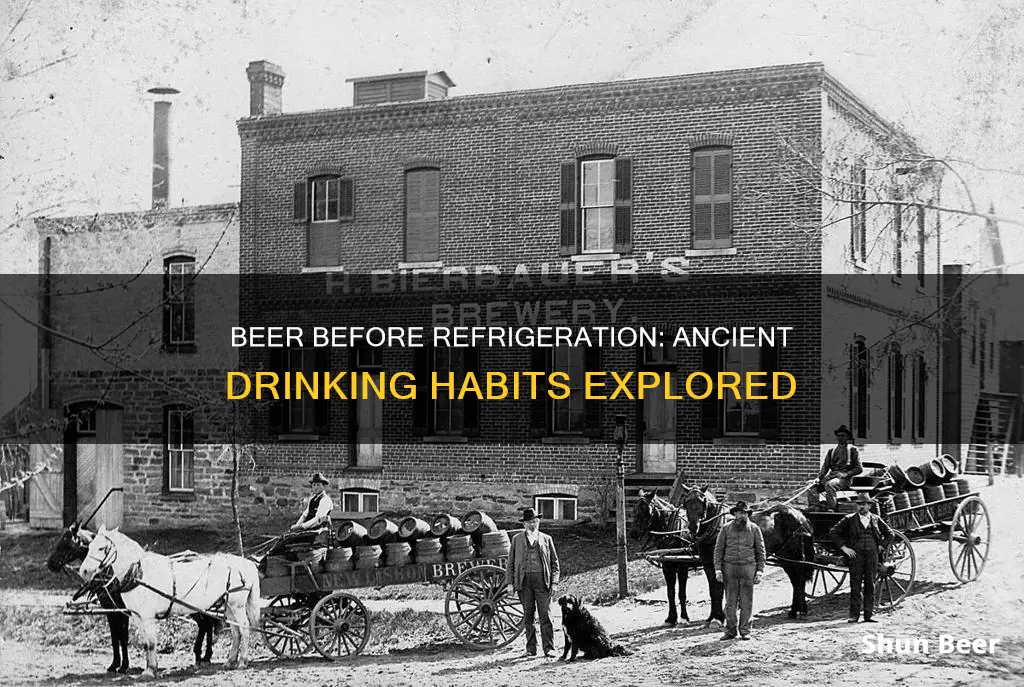
Beer is one of the oldest and most widely consumed alcoholic drinks globally, but it hasn't always been served cold. In ancient times, refrigeration was a luxury, and people relied on various methods to keep their beer cool. In the pre-industrial world, ice houses were often attached to castles, monasteries, and abbeys, serving as a means of refrigeration for the wealthy. Beer was also stored in cellars and caves to keep it cool. Additionally, ancient civilizations like the Greeks, Romans, Chinese, and Mesopotamians dug ice pits to retain ice. Over time, innovations in refrigeration technology made cold beer more accessible to the masses, and it became a popular beverage in early America.
| Characteristics | Values |
|---|---|
| Beer drinking before refrigeration | Beer was consumed at room temperature or chilled using ice from shallow water |
| Refrigeration techniques | Ice pits and ice houses |
| Refrigeration availability | Only available to the wealthy |
| Beer storage | Ice caves and cellars |
| Beer transportation | Carried by servants |
What You'll Learn

Ice and snow were used to cool beer in ancient times
In ancient times, ice and snow were used to cool beer, with the practice dating back to the first century CE in Rome. The Stoic philosopher Seneca, for instance, noted with disdain the trend of dropping lumps of snow into drinks, stating that "nothing is cold enough for some people--hot dishes and snow drinks." The ancient Mediterranean civilizations, including the Greeks and Romans, used ice and snow as a means to cool beverages, with evidence of ancient ice pits dug into the ground and cellars in houses utilized for this purpose.
The use of ice and snow for cooling beer was not limited to the Mediterranean; ancient China and Mesopotamia also had ice pits and ice houses. Persian ice houses, for example, were made of mud bricks, reached up to 20 meters in height, and featured deep pits to hold ice. After Alexander the Great's conquest of the city of Aornus in 327/6 BCE, it is said that he had 30 ice pits dug out and covered with oak.
The pursuit of cold beverages led to various innovations. Emperor Nero of Rome, for instance, is credited with discovering a method to boil water and snow to remove microbes, resulting in distilled water that could be chilled and consumed as a refreshing beverage.
The shape of ceramic vessels from ancient times also indicates the preference for cold drinks. The Greeks and Romans used a vessel called a psykter, which was mushroom-shaped and allowed for the container to float within a larger krater of cold water or snow.
The use of ice houses continued into the medieval and early modern periods, with structures regularly employed in western Europe, often attached to elite residences such as castles, palaces, monasteries, and abbeys. These ice houses were used not only for cooling drinks but also for preserving food.
Building Muscle and Drinking Beer: Is It Possible?
You may want to see also

Beer was stored in cellars and ice pits
Persian ice houses, for instance, were made of mud bricks and could be up to 20 meters high, featuring deep pits that held ice. After Alexander the Great's conquest of the city of Aornus, it is said that he had 30 ice pits dug out and covered with oak to seal them.
The use of cellars and ice pits for beer storage continued into the medieval and early modern periods, with ice houses regularly used in western Europe. These structures were often attached to elite residences, such as castles, palaces, monasteries, and abbeys.
The use of these structures to store beer was not limited to a specific type of beer. However, the development of mechanical refrigeration in the late 19th century made cold lager beers more accessible to the general public, and they began to eclipse the "warm-fermented" ales that were previously dominant.
Stone Cold's Beverage of Choice: Beer for the Bottoms Up
You may want to see also

Beer was brewed and consumed within a short period
Beer is one of the oldest alcoholic drinks in the world, and the third most popular drink overall after water and tea. It is made from the fermentation of starches from cereal grains, most commonly malted barley.
Before the invention of refrigeration, beer was often brewed and consumed within a short period. In ancient Egypt, for example, beer was made and drunk within a week. This was also likely the case in ancient Rome, where Seneca complained about the fashion for putting lumps of snow in drinks to cool them.
In the pre-industrial world, ice houses were used to store ice for cooling drinks, but these were a luxury only available to the wealthy. Beer was also stored in cellars and ice pits, and ancient Chinese and Mesopotamian civilisations built ice pits and ice houses.
The development of refrigeration changed the way beer was brewed and consumed. In 1873, Carl von Linde devised a system of mechanical ice production, making cold lager beers accessible to the masses. Before this, beer was often brewed and consumed within a short period, and drinking chilled beer was a luxury.
Old Beer: Is It Safe to Drink After Three Months?
You may want to see also

Commercial refrigeration made cold beer accessible to the masses
Beer is one of the oldest and most widely consumed alcoholic drinks in the world, but it hasn't always been served cold. In fact, for centuries, cold beer was a luxury that only the wealthy could afford. This changed with the advent of commercial refrigeration, which made cold beer accessible to the masses.
Before the invention of refrigeration, ancient civilizations relied on various methods such as salting, drying, pickling, and smoking to preserve their foods and drinks. In the ancient world, ice and snow were used to cool beverages, and there is evidence of ancient ice pits and ice houses in China, Mesopotamia, Persia, and India. These structures were often attached to elite residences and religious sites, indicating that cold drinks were a luxury item.
The first instances of mechanical refrigeration were developed in the 19th century. One notable example is the Siebe-Harrison refrigerating machine, exhibited in 1851. However, it was James Harrison who invented and patented the first commercial refrigeration system in 1855. Harrison's system used a vapor-compression process with ether as the refrigerant, and it was first employed by a brewery. This innovation revolutionized the brewing industry, as it allowed for the mass production and distribution of cold lager beers.
The availability of commercial refrigeration transformed the way beer was consumed. No longer was it a luxury enjoyed only by the rich, but it became accessible to people from all walks of life. The new technology also facilitated new types of beers, as brewers were no longer limited by the constraints of natural cooling methods. The mass production of cold lager beers led to their widespread popularity, eclipsing the previously dominant "warm-fermented" ales.
The impact of commercial refrigeration extended beyond the brewing industry. The same technology was soon adopted by meatpacking factories, revolutionizing food preservation and distribution. Additionally, the principles of Harrison's design laid the foundation for modern conveniences such as air conditioning, home refrigerators, and supermarket refrigeration.
Today, beer is distributed globally and remains one of the world's most popular alcoholic beverages. The development of commercial refrigeration played a pivotal role in this success story, making cold beer accessible on a large scale and shaping the drinking culture of communities worldwide.
Beer and Ketosis: What You Need to Know
You may want to see also

Beer was stored in caves and ice houses
Ice houses were often attached to castles, palaces, monasteries, and abbeys, and were a symbol of wealth and luxury. Snow and ice were collected from mountains and shallow water sources and stored in these ice houses to keep beverages cool. The ancient Romans, for example, were known to serve wine and food on a bed of snow and ice brought from Italian mountains such as Sicily's Mt. Etna.
The shape of ceramic vessels from ancient times also indicates the preference for cold beverages. The Greeks and Romans used a vessel called a psykter, which was a mushroom-shaped vase that could float in a larger container of cold water or snow. This allowed the beverage inside to stay cool.
The use of ice houses continued into the medieval and early modern periods, and they became more common in western Europe. These structures were used not only for supplying ice but also for preserving food. The beer stored in these ice houses and caves was typically lager, which benefits from being stored in cool conditions.
Beer Drinking Without Weight Gain: Is It Possible?
You may want to see also
Frequently asked questions
In ancient times, beer was consumed cold as a luxury by the wealthy. In Rome, during the first century CE, snow and ice were used to chill drinks. Ancient Chinese, Mesopotamian, and Persian civilisations built ice pits and ice houses to store ice.
Before refrigeration, beer was brewed and consumed within a short period, probably within a week. Beer was also stored in cellars, ice pits, and ice houses.
Unopened beer can last for about 5 to 9 months beyond the expiration date listed on the label if stored at room temperature.
Yes, unopened beer will eventually go bad. If stored at room temperature, it will likely go bad after 4 to 6 months.
Before refrigeration, beer was stored in cellars, ice pits, and ice houses. In ancient China and Mesopotamia, beer was stored in ice pits and ice houses.







